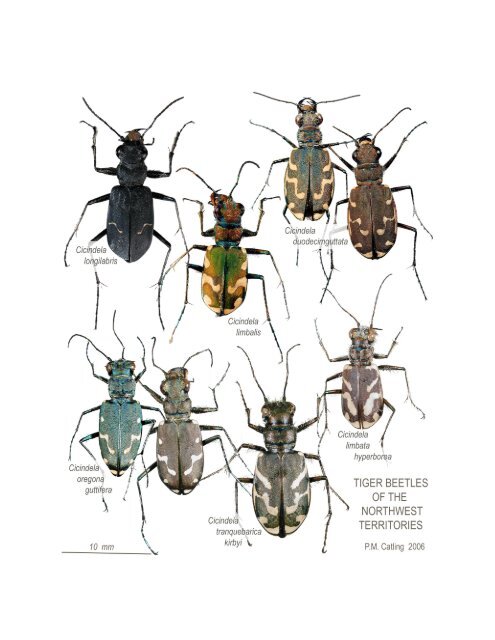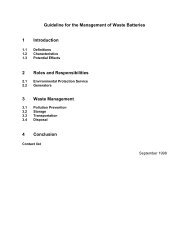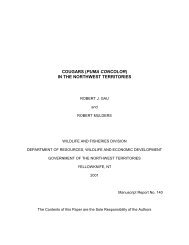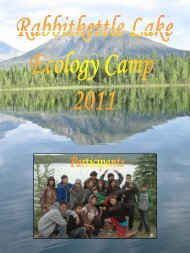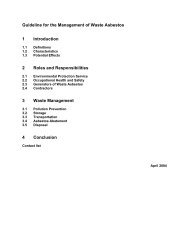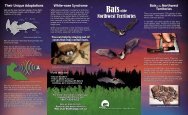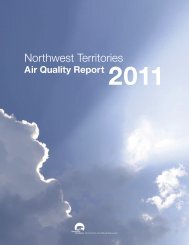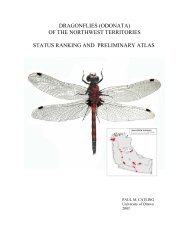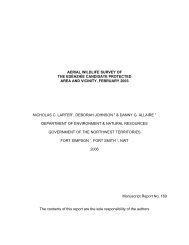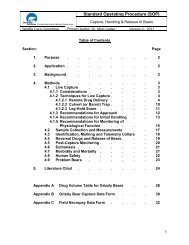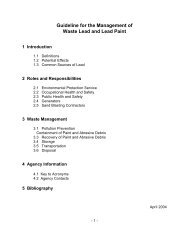Atlas and Key to Tiger Beetles of the Northwest Territories
Atlas and Key to Tiger Beetles of the Northwest Territories
Atlas and Key to Tiger Beetles of the Northwest Territories
Create successful ePaper yourself
Turn your PDF publications into a flip-book with our unique Google optimized e-Paper software.
TIGER BEETLES (CICINDELIDAE)<br />
OF THE<br />
NORTHWEST TERRITORIES:<br />
DISTRIBUTION, STATUS AND OTHER INFORMATION<br />
Paul M. Catling, Biodiversity, National Program on Environmental Health, Agriculture <strong>and</strong> Agrifood<br />
Canada, Wm. Saunders Bldg., Central Experimental Farm, Ottawa, Ontario, Canada K1A<br />
0C6<br />
[catlingp@agr.gc.ca ]<br />
DRAFT 1, March 2006
CONTENTS<br />
ABSTRACT ..................................................................2<br />
INTRODUCTION - TIGER BEETLES OF THE NORTHWEST TERRITORIES ..........2<br />
WHY TIGER BEETLES ......................................................2<br />
MORE ABOUT TIGER BEETLES ................................................3<br />
STUDY OF TIGER BEETLES IN NORTHWEST TERRITORIES ......................3<br />
GATHERING INFORMATION ..................................................4<br />
IDENTIFICATION ............................................................4<br />
IDENTIFICATION KEYS (NORTHWEST TERRITORIES (AND ADJACENT REGIONS) ..4<br />
SPECIES DISTRIBUTIONS AND STATUS IN NORTHWEST TERRITORIES ...........7<br />
Cicindela duodecimguttata, TWELVE SPOTTED TIGER BEETLE .....................9<br />
Cicindela duodecimguttata X oregona, TWELVE SPOTTED HYBRID TIGER BEETLE ...10<br />
Cicindela limbalis, COMMON CLAYBANK TIGER BEETLE ........................11<br />
Cicindela limbata hyperborea, SANDY TIGER BEETLE ............................12<br />
Cicindela longilabris longilabris, BOREAL LONG-LIPPED TIGER BEETLE ............13<br />
Cicindela oregona guttifera, WESTERN TIGER BEETLE ............................14<br />
Cicindela tranquebarica kirbyi, OBLIQUE-LINED TIGER BEETLE ...................15<br />
TIGER BEETLES OF ADJACENT AND/OR NORTHERN REGIONS ..................16<br />
TABLE 1. CHECKLIST OF TIGER BEETLES OF NW NORTH AMERICA ........... .17<br />
REFERENCES ..............................................................18<br />
FRONT COVER: Six species <strong>of</strong> <strong>Tiger</strong> <strong>Beetles</strong> known from <strong>the</strong> <strong>Northwest</strong> Terri<strong>to</strong>ries. Label information as follows<br />
(from left <strong>to</strong> right <strong>and</strong> <strong>to</strong>p <strong>to</strong> bot<strong>to</strong>m): C. longilabris (NWT - Muskeg River, N <strong>of</strong> Fort Liard, 60.3049 N, -123.3153<br />
W, 21 July 2004, P.M. Catling). C. limbalis (NW T - 17 km N <strong>of</strong> BC, 23 June 1988, B.L. <strong>and</strong> J.L.Carr). C.<br />
duodecimguttata (specimen on left (in sleeping position) approaching C. rep<strong>and</strong>a, NWT - Peti<strong>to</strong>t River, S side <strong>of</strong><br />
Fort Liard, 60.2361 N, -123.4830 W , 21 July 2004, P.M. Catling; specimen on right, NWT - Taltson River, 60.3554<br />
N, -111.2760 W, 23 July 2003, P.M. Catling). C. oregona guttifera (greenish specimen on left, YU, Marsh Lake, 6<br />
Aug. 1987, B.F. <strong>and</strong> J.L. Carr; specimen on right, YU, hwy 4, 573 km N <strong>of</strong> hwy 1, 30 July 1987, BF <strong>and</strong> JL Carr ).<br />
C. tranquebarica kirbyi (Salt Plain (W <strong>of</strong> Fort Smith), 11 June 1950). C. limbata hyperborea (Fort Smith, 21 July<br />
1950, J.B. Wallis). All specimens in CNC.<br />
BACK COVER: Some <strong>of</strong> <strong>the</strong> remarkable disjunct occurrences <strong>of</strong> <strong>Tiger</strong> <strong>Beetles</strong> in Yukon <strong>and</strong> Alaska that were<br />
likely present in <strong>the</strong> “Mammoth Steppe” From <strong>to</strong>p <strong>to</strong> bot<strong>to</strong>m. C. limbata nynpha (ALASKA, Nogahabara dunes, 65<br />
m N <strong>of</strong> Galena, 25 June 1989, M. Polak. D.M. Wood). C. terricola terricola (YU, Whitehorse, 7 July 1979, B.F.<br />
<strong>and</strong> J.L. Carr).C. decemnotata (YU, Whitehorse, 4 July 1987, B.F. <strong>and</strong> J.L. Carr). All specimens in CNC.
ABSTRACT<br />
Six species <strong>of</strong> tiger beetles <strong>and</strong> one hybrid are given status ranks in <strong>the</strong> <strong>Northwest</strong> Terri<strong>to</strong>ries<br />
based on number <strong>of</strong> occurrences <strong>and</strong> distributional area within <strong>the</strong> terri<strong>to</strong>ry. Cicindela limbata<br />
hyperborea, a restricted subspecies occurring in <strong>the</strong> Fort Smith area, is ranked as S3 indicating<br />
species that is believed not <strong>to</strong> be at risk <strong>of</strong> extirpation or extinction, but that may require special<br />
attention or protection <strong>to</strong> prevent <strong>the</strong>m from becoming at risk. The remaining species <strong>and</strong> hybrid<br />
including Cicindela duodecimguttata, Cicindela duodecimguttata X oregona, Cicindela limbalis,<br />
Cicindela longilabris longilabris, Cicindela oregona guttifera, <strong>and</strong> Cicindela tranquebarica<br />
kirbyi, are ranked as S4 indicating that <strong>the</strong>y aresecure. The ranking is based on a database <strong>of</strong> 306<br />
records each defined as unique combination <strong>of</strong> date, location <strong>and</strong> collec<strong>to</strong>r, representing 22<br />
localities <strong>and</strong> 865 individuals. Distribution maps <strong>and</strong> notes on ecology <strong>and</strong> classification are<br />
included. Rejected taxa, possible additions <strong>and</strong> species <strong>of</strong> adjacent regions are all discussed.<br />
Information on identification is also included <strong>to</strong> facilitate moni<strong>to</strong>ring.<br />
INTRODUCTION - TIGER BEETLES OF<br />
THE NORTHWEST TERRITORIES<br />
Information is provided here on six species<br />
<strong>of</strong> <strong>Tiger</strong> <strong>Beetles</strong> (Cicindela spp.) that have<br />
been found in <strong>the</strong> <strong>Northwest</strong> Terri<strong>to</strong>ries.<br />
Some regions <strong>of</strong> Canada north <strong>of</strong> 60 North<br />
Latitude have not been adequately surveyed<br />
by en<strong>to</strong>mologists <strong>and</strong> o<strong>the</strong>r species may<br />
occur here, possibly as many as 10. To assist<br />
in moni<strong>to</strong>ring <strong>and</strong> study in this region<br />
information on species in adjacent regions is<br />
included. The work is primarily aimed at<br />
status ranking but will also provide a<br />
benchmark for fur<strong>the</strong>r study in <strong>the</strong> north.<br />
WHY TIGER BEETLES<br />
They are attractively coloured, easily<br />
identified, <strong>and</strong> <strong>the</strong>y are favourite insects.<br />
People have studied <strong>the</strong>m, not because <strong>the</strong>y<br />
are beneficial or because <strong>the</strong>y are pests - but<br />
simply because <strong>the</strong>y are interesting <strong>and</strong> <strong>the</strong>ir<br />
study improves our underst<strong>and</strong>ing <strong>of</strong> <strong>the</strong><br />
natural world. Just as <strong>the</strong>re are field guides<br />
<strong>to</strong> butterflies <strong>and</strong> dragonflies, <strong>the</strong>re is now<br />
also a field guide <strong>to</strong> <strong>Tiger</strong> <strong>Beetles</strong> (Pearson<br />
et al. 2006). There is even a scientific<br />
journal called “Cicindela” devoted entirely<br />
<strong>to</strong> <strong>Tiger</strong> <strong>Beetles</strong>, but <strong>the</strong> best way <strong>to</strong> start is<br />
<strong>to</strong> get a copy <strong>of</strong> John Acorn’s book entitled<br />
“<strong>Tiger</strong> <strong>Beetles</strong> <strong>of</strong> Alberta” (see references).<br />
There are roughly 2.5 thous<strong>and</strong><br />
species <strong>of</strong> <strong>Tiger</strong> <strong>Beetles</strong> worldwide. In North<br />
America <strong>the</strong>re are 109 <strong>and</strong> in Canada <strong>the</strong>re<br />
are 36. There are six in <strong>the</strong> <strong>Northwest</strong><br />
Terri<strong>to</strong>ries. Since <strong>the</strong>y are well known,<br />
widespread <strong>and</strong> have specific habitat<br />
requirements, <strong>the</strong>y serve as valuable<br />
indica<strong>to</strong>rs <strong>of</strong> <strong>the</strong> general state <strong>of</strong> <strong>the</strong><br />
environment. The Canadian species have<br />
recently been given status ranks for each<br />
Canadian province <strong>and</strong> terri<strong>to</strong>ry in order <strong>to</strong><br />
provide a baseline for future moni<strong>to</strong>ring <strong>of</strong><br />
Canadian biodiversity. The information<br />
included here is part <strong>of</strong> <strong>the</strong> development <strong>of</strong><br />
that baseline for <strong>the</strong> north.<br />
MORE ABOUT TIGER BEETLES<br />
<strong>Tiger</strong> <strong>Beetles</strong> are about 1/2 <strong>to</strong> 3/4 inch (1-2<br />
cm) long. The species found in <strong>the</strong><br />
<strong>Northwest</strong> Terri<strong>to</strong>ries occupy more or less<br />
open habitats. Active during <strong>the</strong> day, <strong>the</strong>y<br />
both fly <strong>and</strong> run. Running <strong>the</strong>y can cover 1/2<br />
2
m in a second. They have large m<strong>and</strong>ibles<br />
<strong>and</strong> prey on o<strong>the</strong>r insects. They locate food<br />
by sight <strong>and</strong> live mostly in open places. The<br />
larvae are also carnivorous but <strong>the</strong>y lie in<br />
wait for passing insects at <strong>the</strong> mouths <strong>of</strong><br />
ground burrows. For information on setting<br />
up a terrarium for tiger beetles, especially<br />
for teaching children, see<br />
www.royalalbertamuseum.ca/<br />
natural/insects/projects/tigerbee.htm<br />
Figure 1. Open s<strong>and</strong>y habitat <strong>of</strong> <strong>the</strong> Twelve-spotted <strong>Tiger</strong> Beetle (Cicindela duodecimguttata) on<br />
bank <strong>of</strong> Taltson River east <strong>of</strong> Fort Smith ( 60.3554 N, -111.2760 W). Pho<strong>to</strong> P.M. Catling 2003.<br />
STUDY OF TIGER BEETLES IN<br />
NORTHWEST TERRITORIES<br />
Much <strong>of</strong> <strong>the</strong> information on tiger beetles in<br />
<strong>the</strong> <strong>Northwest</strong> Terri<strong>to</strong>ries was obtained by<br />
en<strong>to</strong>mologists studying biting insects in <strong>and</strong><br />
around 1950 during <strong>the</strong> Nor<strong>the</strong>rn Insect<br />
Survey project. One <strong>of</strong> North America’s<br />
tiger beetle experts, John Braithwaite<br />
Wallis, made an extensive collection <strong>of</strong><br />
3
tiger beetles around Fort Smith during this<br />
project in 1950. He was author <strong>of</strong> <strong>the</strong> major<br />
reference work on <strong>the</strong> tiger beetles <strong>of</strong><br />
Canada, but he studied butterflies <strong>and</strong><br />
dragonflies as well. He was born in Engl<strong>and</strong><br />
in 1877, emigrated <strong>to</strong> Canada in 1893 grew<br />
up near Portage la Prairie, became a teacher,<br />
later a principal <strong>and</strong> organized <strong>the</strong> <strong>the</strong><br />
natural science program for Winnipeg<br />
schools. He retired in 1945, continued his<br />
en<strong>to</strong>mology studies at <strong>the</strong> University <strong>of</strong><br />
Mani<strong>to</strong>ba. Wallis published his classic text<br />
on <strong>the</strong> tiger beetles <strong>of</strong> Canada in 1961 with<br />
<strong>the</strong> help <strong>of</strong> Dr. George Ball (see Acorn<br />
2001). He died <strong>the</strong> following year. Wallis<br />
was a very influential man who stimulated<br />
many <strong>to</strong> an interest in en<strong>to</strong>mology, radiated<br />
enthusiasm <strong>and</strong> a possessed a deep love <strong>of</strong><br />
nature (Reigert 1989). He is commemorated<br />
in <strong>the</strong> very important J.B. Wallis Museum <strong>of</strong><br />
En<strong>to</strong>mology (curated by Dr. Rob Roughley)<br />
at <strong>the</strong> University <strong>of</strong> Mani<strong>to</strong>ba.<br />
The earliest collections <strong>of</strong> tiger<br />
beetles from <strong>Northwest</strong> Terri<strong>to</strong>ries seen by<br />
<strong>the</strong> author are those made by C.H. Crickmay<br />
in 1922 <strong>and</strong> 1923. In a database developed<br />
for this work <strong>the</strong>re are 306 unique records<br />
(unique location <strong>and</strong>/or date <strong>and</strong>/or species<br />
<strong>and</strong>/or collec<strong>to</strong>r) representing 22 locations<br />
<strong>and</strong> including 865 individuals. Most <strong>of</strong> this<br />
information is from <strong>the</strong> CNC (<strong>the</strong> Canadian<br />
National Collection <strong>of</strong> Insects maintained by<br />
Agriculture <strong>and</strong> Agri-Food Canada on <strong>the</strong><br />
Central Experimental Farm in Ottawa).The<br />
database also includes records from <strong>the</strong><br />
Canadian Museum <strong>of</strong> Nature <strong>and</strong> <strong>the</strong> J.B.<br />
Wallis En<strong>to</strong>mology Museum at <strong>the</strong><br />
University <strong>of</strong> Mani<strong>to</strong>ba. All 865 specimens,<br />
were examined <strong>and</strong> verified by <strong>the</strong> author.<br />
The collec<strong>to</strong>rs <strong>of</strong> tiger beetles in<br />
northwestern North America (Alaska (AK),<br />
Yukon (YK), <strong>Northwest</strong> Terri<strong>to</strong>ries (NT)<br />
based on labels in <strong>the</strong> CNC include (name<br />
followed by year <strong>of</strong> collection): J.A. Kucshe<br />
1916 (YK); C.H. Crickmay 1922, 1923<br />
Figure 2. John Braithwaite Wallis, here<br />
shown at Aweme, Mani<strong>to</strong>ba in 1956,<br />
collected three species <strong>of</strong> tiger beetles <strong>and</strong><br />
368 specimens in <strong>the</strong> vicinity <strong>of</strong> Fort Smith<br />
in 1950. These specimens found <strong>the</strong>ir way<br />
in<strong>to</strong> most large collections in Canada but<br />
<strong>the</strong> largest part <strong>of</strong> <strong>the</strong> sample includes 350<br />
specimens at CNC. The Wallis specimens<br />
from NT have been used extensively for<br />
teaching <strong>and</strong> research <strong>and</strong> were studied as<br />
part <strong>of</strong> <strong>the</strong> evaluation <strong>of</strong> hybridization in <strong>the</strong><br />
duodecimguttata group (Freitag 1965).<br />
Wallis is well known for his classic<br />
monograph <strong>of</strong> Canadian tiger beetles<br />
published in 1961. It was remarkable for<br />
<strong>the</strong> time in including colour illustrations <strong>of</strong><br />
all <strong>of</strong> <strong>the</strong> species. Pho<strong>to</strong>graph taken 6 Oct<br />
1956 by Ralph D. Bird (Can. Field- Nat. 86:<br />
393. 1972). Permission <strong>to</strong> use it was kindly<br />
provided by well-known Canadian botanist<br />
C.D. (Charlie) Bird (who collected tiger<br />
beetles at Norman Wells in 1953).<br />
4
(NT); Mason & Hughes 1948 (YK);<br />
W.R.M. Mason 1948, 1949 (AK, NT, YK);<br />
P.F. Bruggemann 1949 (YK); E.F. Cashman<br />
1949 (NT); S.D. Hicks 1949 (NT); ; D.L.<br />
Watson 1949 (NT); L.M. Fisher 1950 (YK);<br />
W.G. Helps 1950 (NT); J. McKay 1950<br />
(NT); P. Rubts<strong>to</strong>ff 1950 (NT); W. Shaeffert<br />
1950 (NT); J.B. Wallis 1950, 1951 (NT);<br />
P.R. Ehrlich 1951; J.E.H. Martin 1951;<br />
W.R.M. Mason 1951; C.D. Bird 1953; J.G.<br />
Chillicott 1953; H.J. Huckel 1955 (YK);<br />
R.B. Leech 1956, 1962 (YK); S.D. Hicks<br />
1957 (NT); G.E. Shewell 1969 (NT); A.<br />
Smetana 1972 (NT); B.E. Bowen 1973<br />
(NT); B.F. & J.L. Carr 1979, 1987, 1988<br />
(NT, YK); D. Lafontaine 1980 (YK); M.<br />
Wood 1982 (YK); M. Polak, D.M. Wood<br />
1989 (AK); <strong>and</strong> P.M. Catling 2003, 2004<br />
(NT).<br />
Interestingly a number <strong>of</strong> specimens<br />
in CNC bear old yellow labels with “NWT”<br />
or “NWT-J.M. 80" A few specimens <strong>of</strong> C.<br />
limbata in <strong>the</strong> collection with <strong>the</strong>se labels<br />
provide a clue <strong>to</strong> <strong>the</strong>ir interpretation. The<br />
specimens belong <strong>to</strong> subspecies nympha <strong>of</strong><br />
<strong>the</strong> prairie region <strong>and</strong> were evidently<br />
collected when “<strong>Northwest</strong> Terri<strong>to</strong>ries”<br />
included much <strong>of</strong> what is now <strong>the</strong> prairie<br />
provinces <strong>and</strong> extended from <strong>the</strong> Dakotas <strong>to</strong><br />
<strong>the</strong> Rockies.<br />
Figure 3. In some places <strong>the</strong> open ground utilized by tiger beetles may be maintained by Wood<br />
Bison like this group on <strong>the</strong> west side <strong>of</strong> Great Slave Lake. Fire <strong>and</strong> drought on coarse substrates<br />
are also fac<strong>to</strong>rs that prevent vegetation from closing in. Pho<strong>to</strong> P.M. Catling 2003.<br />
5
GATHERING INFORMATION<br />
Since <strong>the</strong> ecology <strong>and</strong> distribution <strong>of</strong><br />
tiger beetles is poorly unders<strong>to</strong>od in <strong>the</strong><br />
north, new information in <strong>the</strong> form <strong>of</strong><br />
specimens or pho<strong>to</strong>graphs is welcome. With<br />
regard <strong>to</strong> pho<strong>to</strong>graphy <strong>the</strong> biggest difficulty<br />
is getting close. The easiest way <strong>to</strong> get a<br />
good pho<strong>to</strong>graph is <strong>to</strong> catch <strong>the</strong> beetle in a<br />
net, <strong>the</strong>n place it in a small bottle <strong>and</strong> put it<br />
in <strong>the</strong> cooler overnight. It can be<br />
pho<strong>to</strong>graphed during that cool period in<br />
early morning with blue sky providing<br />
optimal lighting. Habitat can be recreated in<br />
a cereal bowl (which can be later used for<br />
breakfast). When first removed from <strong>the</strong><br />
bottle it will be slow <strong>and</strong> <strong>the</strong>re will be a brief<br />
opportunity for a good pho<strong>to</strong>graph.<br />
With regard <strong>to</strong> collecting, no more<br />
than five specimens need <strong>to</strong> be collected<br />
from any particular location. The specimens<br />
can be placed in any kind <strong>of</strong> envelope with<br />
data (location, date, collec<strong>to</strong>r) written on <strong>the</strong><br />
envelope. The envelope can be placed in <strong>the</strong><br />
freezer <strong>to</strong> kill <strong>the</strong> specimens. Envelopes can<br />
<strong>the</strong>n be put in a dry place <strong>to</strong> allow specimens<br />
<strong>to</strong> dry out. This requires one or two weeks.<br />
To prevent crushing specimens should be<br />
placed in a box. Prior <strong>to</strong> killing, live beetles<br />
can be maintained in a bottle with moist<br />
tissue. Pr<strong>of</strong>essional en<strong>to</strong>mologists prefer <strong>to</strong><br />
kill beetles (<strong>and</strong> o<strong>the</strong>r insects) with a few<br />
drops <strong>of</strong> ethyl acetate on tissue in a bottle<br />
with a tight fitting lid. The liquid is highly<br />
flammable (explodes in<strong>to</strong> fire near a flame),<br />
very volatile <strong>and</strong> <strong>the</strong> vapour is <strong>to</strong>xic. Not<br />
surprisingly, keeping beetles alive until<br />
freezing <strong>and</strong> drying is possible is <strong>of</strong>ten a<br />
preferred method. Specimens can be shipped<br />
dried or frozen but should not be kept in an<br />
airtight container without first drying or<br />
continuous freezing so as <strong>to</strong> prevent rotting.<br />
S<strong>of</strong>t-bodied larvae have <strong>to</strong> be dealt<br />
with differently. Older mature larvae are <strong>the</strong><br />
most useful. They can be killed by<br />
immersion for 15 minutes in hot water (hot<br />
c<strong>of</strong>fee temperature) which leaves <strong>the</strong>m<br />
straight <strong>and</strong> full. They can <strong>the</strong>n be placed in<br />
a bottle with 70% alcohol <strong>and</strong> a label written<br />
in pencil can be placed in <strong>the</strong> same bottle.<br />
IDENTIFICATION<br />
As a group tiger beetles are<br />
distinguished by <strong>the</strong>ir colour patterns <strong>and</strong><br />
<strong>of</strong>ten iridescent colour above <strong>and</strong> below.<br />
There is no paint job in <strong>the</strong> world that can<br />
rival most <strong>of</strong> <strong>the</strong> species close-up in<br />
changing light. O<strong>the</strong>r distinctive features are<br />
<strong>the</strong>ir long thin antennae, long body form<br />
with head wider than <strong>the</strong> thorax, long sickleshaped<br />
m<strong>and</strong>ibles with a few equally spaced<br />
teeth <strong>and</strong> long, thin legs. <strong>Tiger</strong> beetles <strong>of</strong>ten<br />
have pale front (shoulder or humeral area),<br />
middle <strong>and</strong> rear markings on <strong>the</strong> wing<br />
covers (actually hard front wings called<br />
elytra beneath which are <strong>the</strong> folded<br />
transparent wings used for flight). These<br />
markings are more or less distinctive in<br />
shape for <strong>the</strong> different species. Ano<strong>the</strong>r<br />
useful feature is <strong>the</strong> numbers <strong>and</strong> types <strong>of</strong><br />
hair-like setae on various parts <strong>of</strong> <strong>the</strong> body,<br />
especially <strong>the</strong> head. Older individuals may<br />
become bald so that a lack <strong>of</strong> hair is not<br />
always conclusive, but this is not likely <strong>to</strong> be<br />
a problem <strong>of</strong>ten. The most useful<br />
identification guides for <strong>Northwest</strong><br />
Terri<strong>to</strong>ries (in addition <strong>to</strong> <strong>the</strong> information<br />
provided here) are <strong>the</strong> books by Acorn<br />
(2001) <strong>and</strong> Pearson et al. (2006). Additional<br />
images <strong>of</strong> some <strong>of</strong> <strong>the</strong> species treated here<br />
may be viewed online (see Bousquet <strong>and</strong><br />
Goulet 2004). For information on ecology<br />
<strong>and</strong> evolution, see Pearson <strong>and</strong> Vogler<br />
(2001). Freitag’s (1999) catalogue includes<br />
valuable leads <strong>to</strong> many kinds <strong>of</strong> information.<br />
6
IDENTIFICATION KEY FOR ADULT TIGER BEETLES OF NORTHWEST TERRITORIES<br />
(AND ADJACENT REGIONS)<br />
(1) KEY EMPHASIZING MARKINGS (<strong>to</strong> be used with illustrations on front <strong>and</strong> back covers)<br />
1a. Shoulder mark long <strong>and</strong> slanted straight backward beyond angle (elbow) on middle mark ...<br />
.............................................................................2<br />
1b. Shoulder mark short, not extending straight backward beyond “elbow” on middle pale line,<br />
much shorter than <strong>the</strong> angle on middle mark <strong>and</strong> <strong>of</strong>ten curved forward at <strong>the</strong> tip (“C”- or “G”-<br />
shaped) ......................................................................6<br />
2a. Angle <strong>of</strong> middle mark (elbow) prominent or exp<strong>and</strong>ed; pale marks <strong>of</strong>ten narrow <strong>and</strong> not<br />
connected along edge <strong>of</strong> wing covers ..............................tranquebarica kirbyi<br />
2b. Angle <strong>of</strong> middle mark (elbow) not prominent or exp<strong>and</strong>ed or pale markings extensive <strong>and</strong> ..<br />
joined; pale markings narrow or broad, connected along margins <strong>of</strong> wing covers or not ......3<br />
3a. Small <strong>and</strong> narrow, 8-12 mm long; with markings connected by an broad pale line on <strong>the</strong><br />
margins <strong>of</strong> <strong>the</strong> wing covers ........................................terricola terricola<br />
3b. Larger <strong>and</strong> with broader shoulders, 11-15 mm long, ei<strong>the</strong>r lacking a wide marginal b<strong>and</strong> or<br />
with it so wide as <strong>to</strong> join <strong>the</strong> marks leaving only a narrow central coloured area .............4<br />
4a. Shoulder markings broader or as broad as <strong>the</strong> dark space between <strong>the</strong>m <strong>and</strong> <strong>the</strong> middle pale<br />
markings; foot <strong>of</strong> middle mark line well developed ........................ lengi versuta<br />
4b. Shoulder markings ei<strong>the</strong>r narrower than <strong>the</strong> dark space between <strong>the</strong>m <strong>and</strong> <strong>the</strong> middle pale<br />
markings or so wide as <strong>to</strong> join <strong>the</strong> marks leaving only a narrow central coloured area; foot <strong>of</strong><br />
middle mark poorly developed ...................................................5<br />
5a Pale markings joined <strong>to</strong> extent <strong>of</strong> being 80 % pale .................... limbata nympha<br />
5b Pale markings separate, about 50 % pale ........................ limbata hyperborea<br />
6a. Shoulder line transverse or directed forward , “G”-shaped .......hirticollis athabascensis<br />
6b. Shoulder line a dot or a short backwardly projecting line, “C”-shaped .................7<br />
7a. Central mark angled 45 beyond bend (elbow) ...................................8<br />
7b. Central mark not angled beyond bend (elbow) but extending straight downward or less than<br />
45 ........................................................................11<br />
8a. Central mark short beyond angle (<strong>the</strong> distance from <strong>the</strong> foot <strong>to</strong> <strong>the</strong> basal mark <strong>to</strong> <strong>the</strong> spot <strong>of</strong><br />
<strong>the</strong> basal mark as long as <strong>the</strong> downcurved segment <strong>of</strong> <strong>the</strong> middle mark - much shorter than in <strong>the</strong><br />
similar decemnotata ) .................................................... limbalis<br />
8b. Central mark long beyond angle ...............................................9<br />
7
9a. With hairs between eyes; middle <strong>and</strong> rear markings prominent ............. decemnotata<br />
9b. Lacking hairs between eyes; middle <strong>and</strong> rear markings very narrow or none ............10<br />
10. Wing covers smooth <strong>and</strong> shiny with shallow pits ........................ nebraskana<br />
10b. Wing covers rough <strong>and</strong> dull with low protuberances ..................... longilabris<br />
11a. Cental mark not extending <strong>to</strong> edge <strong>of</strong> wing cover; spot <strong>of</strong> basal mark prominent or not;<br />
green, greenish-purple, or brown .................................................12<br />
11b. Central mark usually extending <strong>to</strong> edge <strong>of</strong> wing cover (not always in eastern<br />
duodecimguttata); spot <strong>of</strong> basal mark not prominent; brown ...........................13<br />
12a. Spots <strong>of</strong> basal marks prominent, each 1/4 <strong>the</strong> width <strong>of</strong> <strong>the</strong> wing cover ...... decemnotata<br />
12b. Spots <strong>of</strong> basal marks not prominent, less than 1/6 <strong>the</strong> width <strong>of</strong> <strong>the</strong> wing cover ...........<br />
............................................................................13<br />
13a. Angle (elbow) <strong>of</strong> middle mark not prominent or abrupt <strong>and</strong> middle mark somewhat angled<br />
below elbow<br />
.....................................................................depressula<br />
13b. Angle (elbow) <strong>of</strong> middle mark prominent or abrupt <strong>and</strong> middle mark directed straight<br />
downward from elbow ........................................................14<br />
14a. Thorax squarish, about as long as wide; front (shoulder mark usually continuous<br />
...................................................................... rep<strong>and</strong>a<br />
14b. Thorax trapezoidal <strong>and</strong> wider than long (<strong>and</strong> wider at front than at back); front (shoulder)<br />
mark usually separate spots .....................................................15<br />
15a. 20-30 hairs between eyes; white line along part <strong>of</strong> edge <strong>of</strong> wing cover, central mark <strong>of</strong>ten<br />
broken (but less <strong>of</strong>ten in western than eastern populations) ............... duodecimguttata<br />
15b. 0-5 hairs between eyes; no white line on edge <strong>of</strong> wing cover, central line complete .......<br />
.............................................................. oregona gutiffera<br />
(2) KEY EMPHASIZING MORPHOLOGICAL CHARACTERISTICS<br />
1a. Lacking hair between <strong>the</strong> eyes ................................................2<br />
1b. With many hairs near <strong>the</strong> anterior edge <strong>of</strong> each eye <strong>and</strong>/or between <strong>the</strong> eyes .............4<br />
2a. Labrum shorter than wide; smaller, 8-12 mm long, relatively narrow with narrow shoulders;<br />
pale marks well developed ........................................ terricola terricola<br />
2b. Labrum longer than wide; larger, 12-15 mm long, with broader shoulders; pale marks very<br />
restricted .....................................................................3<br />
3a. Wing covers shiny with low, rounded projections ......................... nebraskana<br />
8
3b. Wing covers not shiny or granular-shiny with a prominent rough surface <strong>of</strong> projections <strong>and</strong><br />
punctures ............................................................longilabris<br />
4a. Hairs only near <strong>the</strong> outer edge <strong>of</strong> each eye, not scattered between eyes .................5<br />
4b. Hairs frequent <strong>and</strong> scattered between <strong>the</strong> eyes ....................................6<br />
5a. With 2-3 hairs above each eye ........................................depressula<br />
5b. With 8-11 hairs above each eye .........................................oregona<br />
6a. Hair on <strong>the</strong> head <strong>and</strong> body lying flat or decurved ..................................7<br />
6b. Hair on <strong>the</strong> head <strong>and</strong> body erect ...............................................8<br />
7a. Pale markings joined <strong>to</strong> extent <strong>of</strong> being 80 % pale .................... limbata nympha<br />
7b. Pale markings separate, about 50 % pale ........................ limbata hyperborea<br />
8a. Upper lip (labrum) with three teeth on central lower edge; wing covers not or less obviously<br />
serrate at <strong>the</strong> tip ...............................................................9<br />
8b. Upper lip (labrum) with one <strong>to</strong>oth on central lower edge or no teeth; wing covers clearly<br />
serrate at <strong>the</strong> tip ..............................................................12<br />
9a. Shoulder mark (humeral lunule) absent or reduced <strong>to</strong> two spots .....................10<br />
9b. Shoulder mark (humeral lunule) long <strong>and</strong> oblique ................................11<br />
10a. Downward arm <strong>of</strong> middle b<strong>and</strong> <strong>of</strong> wing cover short ........................ limbalis<br />
10. Downward arm <strong>of</strong> middle b<strong>and</strong> <strong>of</strong> wing cover long ...................... decemnotata<br />
11a. Upper marginal pale line not complete; light markings less than 40 % <strong>of</strong> surface ........<br />
.............................................................tranquebarica kirbyi<br />
11b. Upper marginal line complete; light markings more than 50% <strong>of</strong> surface .... lengi versuta<br />
12a. Pale areas <strong>of</strong> wing cover reduced, <strong>the</strong> shoulder marking never more than two dots; first<br />
antennal segment with 3 long hairs ...............................................13<br />
12b. Pale areas <strong>of</strong> wing covers complete <strong>and</strong> shoulder spot part <strong>of</strong> a complete marginal line; first<br />
antennal segment with 3-5 long hairs .............................................14<br />
13a. Front maculation complete; pronotum rectangular <strong>and</strong> squarish, length/width = 4/5 ......<br />
.......................................................................rep<strong>and</strong>a<br />
13b. Front maculation broken; pronotum trapezoidal <strong>and</strong> wider frontally, length/width = 4/6 ...<br />
................................................................duodecimguttata<br />
14a. Shoulder spot confluent with marginal line <strong>and</strong> not in <strong>the</strong> form <strong>of</strong> a “C” (limbata) .......7<br />
14b. Shoulder spot more or less distinct <strong>and</strong> forming a more or less distinct inverted “C” ......<br />
..........................................................hirticollis athabascensis<br />
9
Figure 4. Open s<strong>and</strong>y areas such as this knoll in Jack Pine forest near Fort Smith are home <strong>to</strong> C.<br />
longilabris <strong>and</strong> C. limbata hyperborea. Pho<strong>to</strong> P.M. Catling 2003.<br />
SPECIES DISTRIBUTIONS AND STATUS IN NORTHWEST TERRITORIES<br />
For each <strong>of</strong> six species <strong>and</strong> one hybrid <strong>the</strong>re follows a distribution map based on<br />
specimens in CNC (<strong>the</strong> Canadian National Collection <strong>of</strong> Insects maintained by Agriculture <strong>and</strong><br />
Agri-Food Canada on <strong>the</strong> Central Experimental Farm in Ottawa). The accompanying paragraph<br />
includes notes on conservation status <strong>and</strong> taxonomic status.<br />
The ranking system (Carrière <strong>and</strong> Lange 2002) utilizes, when available, information on<br />
population size, trends <strong>and</strong> threats <strong>to</strong> habitat, but this kind <strong>of</strong> information is <strong>of</strong>ten not available<br />
for insects. Consequently ranking relies heavily on probable size <strong>of</strong> range <strong>and</strong> number <strong>of</strong><br />
10
occurrences. Range is considered in terms <strong>of</strong> <strong>the</strong> proportion <strong>of</strong> <strong>the</strong> continental area <strong>of</strong> <strong>Northwest</strong><br />
Terri<strong>to</strong>ries. There is some arbitariness in determining <strong>the</strong> range by delineating a series <strong>of</strong> points<br />
<strong>and</strong> part <strong>of</strong> any delineated area may be unsuitable for occupancy so that <strong>the</strong> areas determined are<br />
<strong>to</strong> be considered both maximum <strong>and</strong> approximate. Number <strong>of</strong> occurrences is best considered in<br />
light <strong>of</strong> <strong>to</strong>tal occurrences. An occurrence or location is here defined as a geographic location for a<br />
species that is removed by at least 1 km from any o<strong>the</strong>r such location. In <strong>the</strong> <strong>Northwest</strong><br />
Terri<strong>to</strong>ries tiger beetles have been recorded at 22 locations (Figure 1). Any species recorded<br />
from less than 2 locations, especially if <strong>the</strong>y were close <strong>to</strong>ge<strong>the</strong>r <strong>and</strong> represented a relatively<br />
small percentage <strong>of</strong> <strong>the</strong> jurisdictional area, would seem worthy <strong>of</strong> an S2 rank. However this rank<br />
denotes species that are clear c<strong>and</strong>idates for a detailed risk assessment. Lacking specific<br />
information on trend <strong>and</strong> threat, this rank cannot be applied but <strong>the</strong>re is little reason <strong>to</strong> suspect<br />
decline <strong>and</strong> also little reason <strong>to</strong> suspect threat. Assuming lack <strong>of</strong> threat <strong>and</strong> decline, <strong>the</strong> species<br />
can be ranked, but S2 is inappropriate (due <strong>to</strong> lack <strong>of</strong> threat or decline). Thus for species with a<br />
very restricted distribution S3 seems most appropriate. This rank indicates species that “are not<br />
believed <strong>to</strong> be at risk <strong>of</strong> extirpation or extinction, but that may require special attention or<br />
protection <strong>to</strong> prevent <strong>the</strong>m from becoming at risk” (Carrière <strong>and</strong> Lange 2002). This category<br />
describes species that have medium priority for consideration.<br />
Using <strong>the</strong> database table <strong>of</strong> 306 distinct (species, location, date, observer) records in<br />
ARVIEW-GIS, maps were produced showing occurrences. Approximate distribution areas were<br />
<strong>the</strong>n calculated by enclosing occurrences in a polygon for which area was au<strong>to</strong>matically<br />
calculated. This area was <strong>the</strong>n expressed as a percentage <strong>of</strong> <strong>the</strong> continental <strong>Northwest</strong> Terri<strong>to</strong>ries<br />
l<strong>and</strong> surface.<br />
Figure 4. Locations where tiger beetles have been collected in <strong>Northwest</strong> Terri<strong>to</strong>ries.<br />
11
Cicindela duodecimguttata Dejean, TWELVE SPOTTED TIGER BEETLE .............<br />
S4<br />
This species is frequently encountered in moist, open areas along s<strong>and</strong>y shorelines <strong>of</strong><br />
rivers <strong>and</strong> lakes. It has an extensive range covering a large portion <strong>of</strong> North America. It reaches<br />
its nor<strong>the</strong>rn limit in <strong>Northwest</strong> Terri<strong>to</strong>ries fur<strong>the</strong>r <strong>to</strong> <strong>the</strong> north than that shown on most range<br />
maps (e.g Pearson et al. 2006).<br />
Some <strong>of</strong> <strong>the</strong> material databased <strong>and</strong> mapped was determined as C. oregona guttifera X<br />
duodecimguttata by Freitag. All <strong>of</strong> <strong>the</strong>se specimens differ from oregona as defined in some keys<br />
(Wallis 1961, Pearson et al. 2006) in having 15-30 hairs between <strong>the</strong> eyes. Many <strong>of</strong> <strong>the</strong><br />
specimens differ from <strong>the</strong> material accepted as C. duodecimguttata only in <strong>the</strong> less restricted pale<br />
marking <strong>and</strong> a slightly more abrupt “elbow” on <strong>the</strong> middle line <strong>of</strong> <strong>the</strong> wing cover. However, clear<br />
groups do not exist <strong>and</strong> specimens assigned <strong>to</strong> ei<strong>the</strong>r species have been found by <strong>the</strong> same<br />
collec<strong>to</strong>r on <strong>the</strong> same date at <strong>the</strong> same location. Completely distinct hybrids have a more<br />
restricted distribution shown with a separate map following.<br />
Specimens <strong>of</strong> C. duodecimguttata from <strong>Northwest</strong> Terri<strong>to</strong>ries resemble some from <strong>the</strong><br />
Great Plains in <strong>the</strong>ir complete markings <strong>and</strong> relatively narrow pronotum. All specimens from<br />
<strong>Northwest</strong> Terri<strong>to</strong>ries that I have seen that were possibly referable <strong>to</strong> C. rep<strong>and</strong>a on <strong>the</strong> basis <strong>of</strong><br />
maculation had <strong>the</strong> maximum width/length <strong>of</strong> pronotum greater than 2.3 as well as abundant hair<br />
between <strong>the</strong> eyes suggesting that <strong>the</strong>y should be placed with C. duodecimguttata despite <strong>the</strong> fact<br />
that some have <strong>the</strong> central line <strong>and</strong> shoulder line complete as is usually <strong>the</strong> case with C. oregona<br />
guttifera.<br />
General locations: Fort Smith area, Fort Simpson, Taltson River, Yellowknife, Fort Liard,<br />
Norman Wells, Canol, Resolution, Hay River<br />
Number <strong>of</strong> occurrences: 11<br />
Distribution: 57,204 square miles, 148,157 square km, 12.9 %<br />
12
Cicindela duodecimguttata Dejean X oregona Dejean guttifera LeConte<br />
TWELVE SPOTTED HYBRID TIGER BEETLE ..................................<br />
S4<br />
Freitag (1965) published a detailed study <strong>of</strong> hybridization in <strong>the</strong>se species. At Norman<br />
Wells he found <strong>the</strong> only population that was comprised mostly <strong>of</strong> hybrids. At this location only<br />
6.9 % were referable <strong>to</strong> one or <strong>the</strong> o<strong>the</strong>r parent. The influence <strong>of</strong> hybridization diminished<br />
eastwards. A population sample from Fort Smith was found <strong>to</strong> be referable <strong>to</strong> C.<br />
duodecimguttata with introgression <strong>of</strong> C. oregona guttifera.. The particularly well established<br />
hybrid populations in <strong>the</strong> Mackenzie valley are <strong>of</strong> interest with regard <strong>to</strong> evolution <strong>and</strong><br />
evolutionary his<strong>to</strong>ry in this group <strong>and</strong> also represent unique <strong>and</strong> restricted genetic variants.<br />
General locations: Norman Wells, Fort Simpson <strong>and</strong> Canol<br />
Number <strong>of</strong> occurrences: 3<br />
Distribution: 1,743 square miles, 4514 square km, 0.39 %<br />
13
Cicindela limbalis Klug, COMMON CLAYBANK TIGER BEETLE ...................<br />
S4<br />
Often encountered in open areas with fine textured substrate such as clay or eroded<br />
limes<strong>to</strong>ne, this species usually positions its larval burrows on steep clay banks. Nor<strong>the</strong>rn<br />
populations are more greenish (see cover) <strong>and</strong> have been distinguished as subspecies spreta<br />
LeConte, but <strong>the</strong> differences are regarded as slight <strong>and</strong> a northwestern subspecies is generally not<br />
recognized (Wallis 1961, p. 42, Pearson et al. 2006).<br />
Although widespread, this species is ra<strong>the</strong>r habitat-restricted <strong>and</strong> not always as common<br />
as <strong>the</strong> common name implies. It is said <strong>to</strong> be extirpated in sou<strong>the</strong>rn New Engl<strong>and</strong> except for a<br />
population on legendary Block Isl<strong>and</strong> (<strong>the</strong> last st<strong>and</strong> <strong>of</strong> <strong>the</strong> North American Burying Beetle in <strong>the</strong><br />
east).<br />
General locations: Norman Wells, Hay River, Martin River, Fort Wrigley, Fort Liard, Fort<br />
Simpson<br />
Number <strong>of</strong> occurrences: 7<br />
Distribution: 36,869 square miles, 95,490 square km, 8.3 %<br />
14
Cicindela limbata Say hyperborea LeConte, SANDY TIGER BEETLE .................<br />
S3<br />
The species is found in dry s<strong>and</strong>y blow out dunes, <strong>of</strong>ten far from water. It has a primarily<br />
prairie distribtuion. The subspecies hyperborea is small, dark reddish-brown or occasionally<br />
bluish or reddish-bronze <strong>and</strong> with less extensive maculation than subspecies nympha <strong>of</strong> <strong>the</strong><br />
nor<strong>the</strong>rn Great Plains (which is disjunct in northwestern Alaska <strong>and</strong> may be associated with<br />
extensive areas <strong>of</strong> pure blowing s<strong>and</strong>). Subspecies hyperborea has a generally restricted<br />
distribution being endemic <strong>to</strong> nor<strong>the</strong>rn Canadian zone <strong>of</strong> Saskatchewan (Hooper 1969),<br />
northwestern Alberta (Acorn 2001) <strong>and</strong> <strong>the</strong> Fort Smith area <strong>of</strong> <strong>Northwest</strong> Terri<strong>to</strong>ries. Of 22<br />
localities in Northwwest Terri<strong>to</strong>ries where <strong>Tiger</strong> <strong>Beetles</strong> have been found, this one has only been<br />
found in <strong>the</strong> vicinity <strong>of</strong> Fort Smith. Its limited overall distribution as well as its very limited<br />
occurrence in <strong>Northwest</strong> Terri<strong>to</strong>ries make it a species <strong>of</strong> particular interest. Based on current<br />
knowledge this subspecies might be regarded as an endemic <strong>of</strong> <strong>the</strong> northwestern boreal forest.<br />
In 1950, 80 individuals were collected at Fort Smith throughout <strong>the</strong> summer by W.<br />
Schaeffert, J.B. Wallis <strong>and</strong> W.G. Helps. They were found from 24 May until 29 August with <strong>the</strong><br />
largest numbers collected in late July.<br />
The related but more isolated C. limbata labradorensis at Goose Bay, Labrador may be a<br />
recent introduction by man or a periglacial relict (Larson 1986) worthy <strong>of</strong> recognition as a<br />
distinct subspecies (Johnson 1989).<br />
General locations: Fort Smith<br />
Number <strong>of</strong> occurrences: 1<br />
Distribution: less than10 square miles, less than 25.9 square km, 0.002 %<br />
15
Cicindela longilabris Say longilabris, BOREAL LONG-LIPPED TIGER BEETLE .......<br />
S4<br />
Specimens from <strong>Northwest</strong> Terri<strong>to</strong>ries are black like most from <strong>the</strong> boreal forest, but in<br />
<strong>the</strong> serpentine mountains <strong>of</strong> eastern Canada in Newfoundl<strong>and</strong>, Gaspé <strong>and</strong> Labrador <strong>the</strong>y are<br />
bright green. In <strong>the</strong> western mountains various subspecies are bronze or olive-green. This species<br />
is <strong>of</strong>ten found in s<strong>and</strong>y areas within Jack Pine forest, where <strong>the</strong> beetles may benefit from looking<br />
a little like black bits <strong>of</strong> pine charcoal, but this nor<strong>the</strong>rn species may also benefit by warmth from<br />
its black colouration (see discussion in Acorn 2001).<br />
General Locations: Muskeg River near Fort Liard, Fort Smith area, Yellowknife, Resolution,<br />
Norman Wells<br />
Number <strong>of</strong> occurrences: 9<br />
Distribution: 86,630 square miles, 224,370 square km, 19.6 %<br />
16
Cicindela oregona Dejean guttifera LeConte, WESTERN TIGER BEETLE .............<br />
S4<br />
A species <strong>of</strong> <strong>the</strong> open, gravelly shores <strong>of</strong> mountain streams, this one occurs mainly in <strong>the</strong> western<br />
mountains. It is confined in <strong>Northwest</strong> Terri<strong>to</strong>ries <strong>to</strong> <strong>the</strong> Mackenzie valley region where reported<br />
by Freitag (1965) <strong>to</strong> hybridize with C. duodecimguttata.<br />
General Locations: Norman Wells, Canol, Fort Good Hope <strong>and</strong> <strong>the</strong> South Nahanni River<br />
Number <strong>of</strong> occurrences: 4<br />
Distribution: 5,359 square miles, 13,879 square km, 1.2 %<br />
17
Cicindela tranquebarica Herbst kirbyi LeConte, OBLIQUE-LINED TIGER BEETLE .....<br />
S4<br />
This species occurs in a greater variety <strong>of</strong> habitats (mud, s<strong>and</strong>, clay, saltflats) than some<br />
<strong>of</strong> <strong>the</strong> o<strong>the</strong>r species. Many have been collected on <strong>the</strong> Salt Plains W <strong>of</strong> Fort Smith <strong>and</strong> elsewhere<br />
in <strong>the</strong> vicinity. It appears <strong>to</strong> be locally common in that area despite a restricted distribution in<br />
<strong>Northwest</strong> Terri<strong>to</strong>ries. More information on its occurrence at Norman Wells is needed. A single<br />
specimen was collected here by C.H. Crickmay on 14 August 1922. It is correctly identified <strong>and</strong><br />
<strong>the</strong>re is no particular reason <strong>to</strong> suspect a labelling error.<br />
The subspecies borealis Harris has been reported from <strong>Northwest</strong> Terri<strong>to</strong>ries by Bousquet<br />
(1991) but is a weakly defined subspecies <strong>and</strong> not shown <strong>to</strong> occur in <strong>the</strong> region by Pearson et al.<br />
(2006). A few specimens, including <strong>the</strong> one from Norman Wells, have <strong>the</strong> thin maculations<br />
characteristic <strong>of</strong> this subspecies.<br />
General Locations: Fort Smith area <strong>and</strong> Salt Plains <strong>to</strong> <strong>the</strong> west, Fort Norman (Norman Wells).<br />
Number <strong>of</strong> occurrences: 4<br />
Distribution: 6,000 square miles, 15,539 square km, 1.3 %<br />
18
TIGER BEETLES OF ADJACENT AND/OR NORTHERN REGIONS<br />
<strong>Tiger</strong> beetles extend much fur<strong>the</strong>r north in western Canada than in eastern Canada. Larochelle<br />
(1974) reports <strong>the</strong> nor<strong>the</strong>rnmost records for Quebec as Cicindela longilabris <strong>and</strong> Cicindela<br />
tranquebarica, both at 51 30' N near Fort Rupert in Mistassini Terri<strong>to</strong>ry. In adjacent Yukon 5<br />
species <strong>of</strong> tiger beetles have been recorded <strong>and</strong> <strong>the</strong>re are 6 in Alaska (Bousquet 1991, Bousquet<br />
<strong>and</strong> Larochelle 1993, Freitag 1999, CNC, Table 1). Cicindela decemnotata <strong>and</strong> C. terricola<br />
terricola from Yukon have not been found in <strong>Northwest</strong> Terri<strong>to</strong>ries <strong>and</strong> are perhaps relicts <strong>of</strong> <strong>the</strong><br />
once widespread Mammoth Steppe, as is subspecies nympha <strong>of</strong> C. limbata which is disjunct in<br />
northwestern Alaska. There are no records <strong>of</strong> tiger beetles from Nunavut. Some <strong>of</strong> <strong>the</strong> following<br />
species may exist as isolated disjuncts in parts <strong>of</strong> <strong>the</strong> <strong>Northwest</strong> Terri<strong>to</strong>ries. Listed below are<br />
species that occur south <strong>of</strong> 60 N <strong>and</strong> west <strong>of</strong> <strong>Northwest</strong> Terri<strong>to</strong>ries.<br />
Cicindela decemnotata Say, BADLANDS TIGER BEETLE<br />
This species is disjunct from <strong>the</strong> prairies <strong>to</strong> <strong>the</strong> Whitehorse <strong>and</strong> Kluane regions <strong>of</strong> Yukon<br />
(specimens at CNC) <strong>and</strong> also in eastern Alaska.<br />
Cicindela hirticollis Say athabascensis Graves, HAIRY-NECKED TIGER BEETLE<br />
The active dunes on Lake Athabasca where this <strong>and</strong> o<strong>the</strong>r tiger beetles occur (see Acorn<br />
1994) are close <strong>to</strong> <strong>Northwest</strong> Terri<strong>to</strong>ries.<br />
Cicindela lengi W. Horn versuta Casey, BLOWOUT TIGER BEETLE<br />
This prairie species occurs in nor<strong>the</strong>rn Saskatchewan <strong>and</strong> Alberta <strong>and</strong> very near <strong>to</strong> <strong>the</strong><br />
<strong>Northwest</strong> Terri<strong>to</strong>ries in <strong>the</strong> Lake Athabasca s<strong>and</strong> dunes (Acorn 1994).<br />
Cicindela limbata Say nympha Casey, SANDY TIGER BEETLE<br />
As noted by Pearson et al. (2006) a population disjunct from <strong>the</strong> prairie region that is<br />
apparently referable <strong>to</strong> nympha occurs in <strong>the</strong> Nogahabara dunes <strong>of</strong> northwestern Alaska<br />
(specimens at CNC) <strong>and</strong> it is also reported from <strong>the</strong> Great Kobuk dunes north <strong>of</strong> <strong>the</strong><br />
Arctic Circle near Kobuk, Alaska (Pearson et al. 2006).<br />
Cicindela nebraskana Casey, PRAIRIE LONG-LIPPED TIGER BEETLE<br />
Although mapped for <strong>the</strong> Yukon by Wallis (as C. montana) <strong>and</strong> with reference <strong>to</strong><br />
occurrence in Yukon, I have seen no correctly determined specimens. Two specimens<br />
collected by Wood on Carcross dunes <strong>and</strong> determined as this species have <strong>the</strong> surface <strong>of</strong><br />
<strong>the</strong> wing covers rough with protuberances ra<strong>the</strong>r than smooth with shallow pits. They are<br />
thus placed with C. longilabris Some <strong>of</strong> <strong>the</strong> o<strong>the</strong>r characters used <strong>to</strong> identify C.<br />
nebraskana in <strong>the</strong> south such as <strong>the</strong> black underside (Acorn 2001) do not seem <strong>to</strong> work as<br />
well in <strong>the</strong> north.<br />
Cicindela rep<strong>and</strong>a Dejean, BRONZED TIGER BEETLE<br />
This species occurs in nor<strong>the</strong>rn Alberta <strong>and</strong> Saskatchewan. Sixty degrees is 150 km N <strong>of</strong><br />
limit shown by Pearson et al. (2006) <strong>and</strong> Wallis (1961). Although reported from<br />
<strong>Northwest</strong> Terri<strong>to</strong>ries by Bousquet (1991), Bousquet <strong>and</strong> Larochelle (1993) <strong>and</strong> Freitag<br />
(1999), I have not seen justifying specimens. See also notes on C. duodecimguttata<br />
above.<br />
Cicendela terricola Say terricola, GRASS-RUNNER or VARIABLE TIGER BEETLE<br />
(= C. cinctpennis, C. pusilla cinctipennis)<br />
Widespread in <strong>the</strong> prairie region, isolated disjunct populations <strong>of</strong> <strong>the</strong> nominate subspecies<br />
19
from <strong>the</strong> Great Plains exist in west central Alberta <strong>and</strong> in Yukon near Whitehorse. This is<br />
a small species 8-10 mm long. The northwestern populations have pitted wing covers <strong>and</strong><br />
are considered a separate species (C. pusilla Say) by some authors but not Pearson et al.<br />
(2006).<br />
TABLE 1. CHECKLIST OF TIGER BEETLES OF NORTHWESTERN NORTH AMERICA<br />
NORTH OF 60 (ALASKA, YUKON AND NORTHWEST TERRITORIES). Ranks are: 2 = at<br />
risk (species that may be at risk <strong>of</strong> extirpation or extinction <strong>and</strong> are <strong>the</strong>refore c<strong>and</strong>idates for a<br />
detailed risk assessment; 3 = sensitive (species that is believed not <strong>to</strong> be at risk <strong>of</strong> extirpation or<br />
extinction, but that may require special attention or protection <strong>to</strong> prevent <strong>the</strong>m from becoming at<br />
risk; 4 = secure (species which are not believed <strong>to</strong> be at risk or sensitive); 5 = undetermined<br />
(species for which insufficient data, information, or knowledge is available <strong>to</strong> reliably evaluate<br />
<strong>the</strong>ir status).<br />
Scientific Name Common Name AK YU NT NU<br />
Cicindela longilabris Say<br />
Cicindela duodecimguttata Dejean<br />
Cicindela oregona Dejean guttifera<br />
LeConte<br />
Cicindela limbata Say hyperborea<br />
LeConte<br />
Cicindela limbata Say nympha<br />
Casey<br />
Cicindela limbalis Klug<br />
Cicindela decemnotata Say<br />
BOREAL LONG-LIPPED TIGER BEETLE<br />
widespread<br />
TWELVE-SPOTTED TIGER BEETLE<br />
S side <strong>of</strong> Great Slave Lake<br />
WESTERN TIGER BEETLE<br />
MacKenzie valley<br />
SANDY TIGER BEETLE<br />
confined <strong>to</strong> nor<strong>the</strong>rn Alberta, nor<strong>the</strong>rn<br />
Saskatchewan <strong>and</strong> adjacent <strong>Northwest</strong><br />
Terri<strong>to</strong>ries<br />
SANDY TIGER BEETLE<br />
N <strong>of</strong> 60 confined <strong>to</strong> northwestern Alaska<br />
COMMON CLAYBANK TIGER BEETLE<br />
lower MacKenzie valley<br />
BADLANDS TIGER BEETLE<br />
in central Yukon<br />
6 4 4 -<br />
- - 3 -<br />
6 4 5 -<br />
- - 4 -<br />
6 - - -<br />
- - 4 -<br />
6 4 - -<br />
Cicindela terricola Say terricola GRASS-RUNNER TIGER BEETLE - 3 - -<br />
Cicindela tranquebarica Herbst<br />
kirbyi LeConte<br />
OBLIQUE-LINED TIGER BEETLE<br />
southwestern NT border<br />
- 2 4 -<br />
Cicindela depressula Casey<br />
depressula<br />
DISPIRITED TIGER BEETLE<br />
montane subspecies from Haines area <strong>of</strong><br />
Alaska sothward<br />
6<br />
- - -<br />
Cicindela depressula Casey<br />
eureka Fall<br />
DISPIRITED TIGER BEETLE<br />
coastal subspecies from Haines area <strong>of</strong><br />
Alaska southward<br />
6 - - -<br />
20
REFERENCES<br />
Acorn, J.H. 1991. <strong>Tiger</strong> beetles (Coleoptera: Cicindelidae) <strong>of</strong> <strong>the</strong> Lake Athabasca s<strong>and</strong> dunes -<br />
an intriguing nor<strong>the</strong>rn assemblage. Cicindela 26: 9-16.<br />
Acorn, J.H. 2001. <strong>Tiger</strong> beetles <strong>of</strong> Alberta. University <strong>of</strong> Alberta Press, Ring House 2,<br />
Edmon<strong>to</strong>n, Albeta. 120 pp. [www.uap.ualberta.ca/UAP.aspLID=41&bookID=261]<br />
Bousquet, Y. Ed. 1991. Checklist <strong>of</strong> <strong>the</strong> beetles <strong>of</strong> Canada <strong>and</strong> Alaska. Agriculture <strong>and</strong> Agri-<br />
Food Canada. 430 pp. [www.canacoll.org/Coleo/<br />
Checklist/PDF%20files/CARABIDAE.pdf ]<br />
Bousquet, Y. <strong>and</strong> H. Goulet. 2004. The ground beetles <strong>of</strong> Canada.<br />
http://www.cbif.gc.ca/spp_pages/carabids/phps/index_e.php<br />
Bousquet, Y. <strong>and</strong> A Larochelle, 1993 Catalogue <strong>of</strong> <strong>the</strong> Geadephaga (Coleoptera: Trachypachidae,<br />
Rhysodiddae, Carabidae including Cicindelini) <strong>of</strong> America North <strong>of</strong> Mexico. Memoirs <strong>of</strong><br />
<strong>the</strong> En<strong>to</strong>mological Society <strong>of</strong> Canada - No. 167. 397 pp.<br />
Carrière, S. <strong>and</strong> J. Lange. 2002. Detailed procedures manual - general status ranks <strong>of</strong> wild species<br />
in <strong>the</strong> <strong>Northwest</strong> Terri<strong>to</strong>ries. Dept. <strong>of</strong> Resources, Wildlife <strong>and</strong> Economic Development,<br />
Government <strong>of</strong> <strong>the</strong> <strong>Northwest</strong> Terri<strong>to</strong>ries. Manuscript Report 143. 58 pp.<br />
Freitag, R. 1965. A revision <strong>of</strong> <strong>the</strong> North American species <strong>of</strong> <strong>the</strong> Cicindela maritima group with<br />
a study <strong>of</strong> hybridization between between Cicindela duodecimguttata <strong>and</strong> oregona.<br />
Quaestiones En<strong>to</strong>imologicae 1: 87-170.<br />
Freitag, R. 1999. Catalogue <strong>of</strong> <strong>the</strong> tiger beetles <strong>of</strong> Canada <strong>and</strong> <strong>the</strong> United States. NRC Research<br />
Press, Ottawa. 195 pp.<br />
Hilchie, G.J. 1985. The tiger beetles <strong>of</strong> Alberta (Coleoptera: Carabidae, Cicindelini).<br />
Quaestiones En<strong>to</strong>imologicae 21: 319-347.<br />
Hooper, R.R. 1969. A review <strong>of</strong> Saskatchewan tiger beetles. Cicindela 1(4): 1-5.<br />
Johnson, W.N. A new subspecies <strong>of</strong> Cicindela limbata Say from Labrador (Coleoptera:<br />
Cicindelidae). Le Naturaliste Canadien 116:261-266.<br />
Larochelle, A. 1974. The nor<strong>the</strong>rn limits <strong>of</strong> Cicindelidae in Quebec. Cicindela 6(4): 87-88.<br />
Larson, D.J. 1986. The tiger beetle, Cicindela limbata hyperborea LeConte, in Goose Bay,<br />
Labrador (Coleoptera: Cicindelidae). The Coleopterist’s Bulletin 40(3): 249-250.<br />
21
Pearson, D.L., C.B. Knisely <strong>and</strong> C.J. Kazilek. 2006. A field guide <strong>to</strong> <strong>the</strong> <strong>Tiger</strong> <strong>Beetles</strong> <strong>of</strong> <strong>the</strong><br />
United States <strong>and</strong> Canada. Oxford University Press, New York. 227 pp.<br />
Pearson, D.L. <strong>and</strong> A.P. Vogler. 2001. <strong>Tiger</strong> beetles - <strong>the</strong> evolution, ecology <strong>and</strong> diversity <strong>of</strong> <strong>the</strong><br />
Cicindelids. Cornell University Press. Ithaca 333 pp.<br />
Reigert, P.W. 1989. En<strong>to</strong>mologists <strong>of</strong> Mani<strong>to</strong>ba. En<strong>to</strong>mological Society <strong>of</strong> Canada <strong>and</strong><br />
En<strong>to</strong>mological Society <strong>of</strong> Mani<strong>to</strong>ba. Friesen Printers, Al<strong>to</strong>na, MB. 89 pp.<br />
Wallis, J.B. 1961. The Cicindelidae <strong>of</strong> Canada. University <strong>of</strong> Toron<strong>to</strong> Press. Toron<strong>to</strong>, Canada. 74<br />
pp.<br />
22


